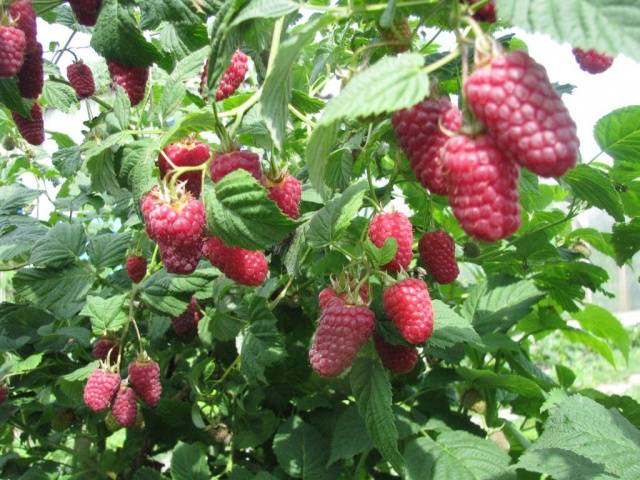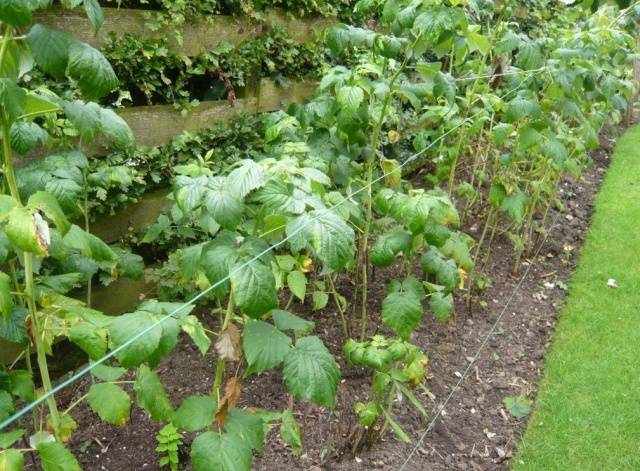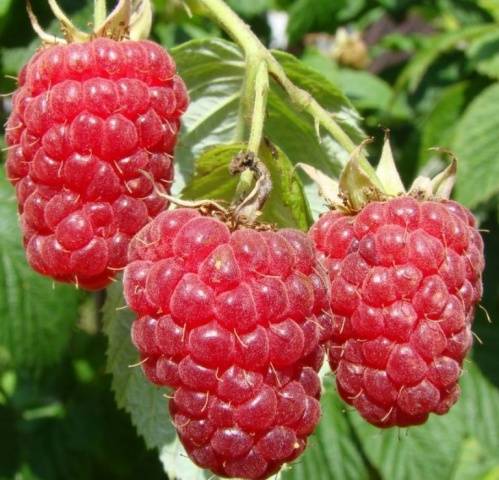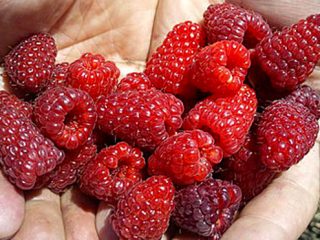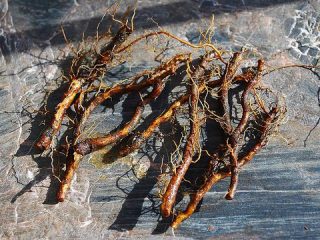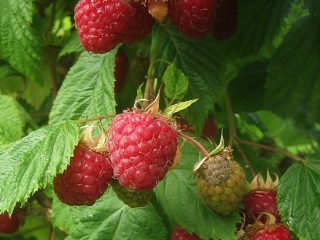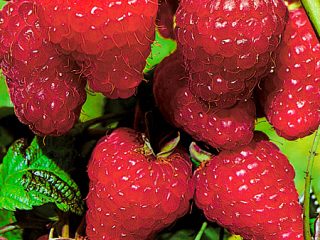Content
Raspberries Terenty was bred by Russian breeder V.V. Kichina in 1994. The variety is a representative large-fruited and standard raspberries. Terenty was obtained as a result of cross-pollination of varieties Patricia and Tarusa. Since 1998, the variety was given a name, and Terenty appeared on the Russian market.
Characteristics of the variety
Description of the raspberry variety Terenty:
- bush height from 120 to 150 cm;
- powerful straight shoots drooping during fruiting;
- dark green corrugated leaves;
- large leaf plate with sharp tips;
- strong stems without tapering at the apex;
- During the season, raspberries grow 8-10 replacement shoots;
- weak formation of root shoots (no more than 5 shoots);
- absence of thorns;
- faint waxy coating on raspberry branches;
- light green bark, darkening over time;
- fruit buds appear along the entire length of the branch;
- powerful brushes that form 20-30 ovaries.
Description and photo of Terenty raspberry:
- fruit weight from 4 to 10 g, on the lower shoots - up to 12 g;
- elongated cone shape;
- large fruit;
- bright colors;
- shiny surface;
- large drupes with a medium degree of cohesion;
- unripe fruits do not have a distinct taste;
- ripe raspberries acquire a sweet taste;
- after acquiring a bright color, the fruits require time for final ripening;
- tender pulp.
Berries of the Terenty variety are not suitable for transportation. After collection, they are consumed fresh or processed. On bushes in wet weather, the fruits become limp and moldy.
The harvest is harvested early. In the middle zone, fruiting begins at the end of July and lasts 3-4 weeks. Individual berries are harvested until September.
One raspberry bush produces 4-5 kg of berries. Under favorable climatic conditions and care, the yield of the Terenty variety increases to 8 kg.
Planting raspberries
The Terenty variety is planted in prepared areas with good lighting and fertile soil. For planting, select healthy seedlings with 1-2 shoots and developed roots.
Preparing the site
Malina Terenty prefers well-lit areas. When planted in the shade, the shoots stretch out, the yield decreases and the taste of the berries deteriorates.
Raspberries grow in one place for 7-10 years, after which the soil becomes depleted. The best predecessors are grains, melons and legumes, garlic, onions, and cucumbers.
Abundant harvests are obtained when raspberries are planted in light loamy soil that retains moisture well. Low-lying areas and slopes are not suitable for raspberries due to moisture accumulation. At higher elevations, the crop experiences a lack of moisture. The location of groundwater should be from 1.5 m.
Work order
Terenty raspberries are planted in autumn or spring. Preparation of the pit begins 2-3 weeks before planting the seedlings.
Seedlings of the Terenty variety are purchased from specialized nurseries. When choosing planting material, pay attention to the root system.Healthy seedlings have elastic roots, not dry or flaccid.
Planting Terenty raspberries includes a number of stages:
- First you need to dig a hole with a diameter of 40 cm and a depth of 50 cm.
- 0.5 m is left between plants, and the rows are spaced in 1.5 m increments.
- Fertilizers are added to the top soil layer. 10 kg of humus, 500 g of wood ash, 50 g of double superphosphate and potassium salt are added to each pit.
- The roots of the seedling are dipped in a mixture of mullein and clay. Growth stimulants Kornevin help improve plant survival.
- Raspberries are trimmed and left at a height of 30 cm.
- The seedling is placed in a hole so that the root collar is at ground level, the roots are covered with earth.
- The soil is compacted and the raspberries are watered abundantly.
- When the water is absorbed, the soil is mulched with humus or dried straw.
Another option is to dig a trench 0.3 m deep and 0.6 m wide. Rotted manure in a 10 cm layer, superphosphate and fertile soil are placed at the bottom of the trench. Raspberries are planted in the same way and watered well.
Variety care
The Terenty variety gives high yields with constant care. Bushes need watering and fertilizing. Performed in spring and autumn raspberry pruning. Despite the variety's resistance to diseases, it is recommended to take measures to prevent them.
Watering and fertilizing
Standard raspberries do not tolerate drought and heat. In the absence of precipitation, the bushes are watered every week with warm, settled water.
Recommended watering intensity for Terenty raspberries:
- at the end of May, 3 liters of water are added under the bush;
- in June and July, raspberries are watered 2 times a month with 6 liters of water;
- Until mid-August, one watering is performed.
In October, the raspberry tree is watered before winter. Due to the moisture, the plants will better tolerate frosts and begin to actively develop in the spring.
After watering the raspberries, the soil is loosened so that the plants can better absorb nutrients. Mulching with humus or straw will help maintain soil moisture.
Terenty raspberries are fed with mineral fertilizers and organic matter. In spring, plantings are watered with mullein solution in a ratio of 1:15.
During the fruiting period, 30 g of superphosphate and potassium salt are embedded in the soil per 1 m2. In autumn, the soil is dug up and fertilized with humus and wood ash.
Trimming
In the spring, the frozen branches of the Terenty raspberry are cut off. 8-10 shoots are left per bush, they are shortened by 15 cm. By reducing the number of shoots, larger raspberries are obtained.
In the fall, two-year-old shoots that bear berries are pruned. Young weak shoots are also eliminated, since they will not survive the winter. Cut raspberry branches are burned to avoid the spread of diseases and pests.
Protection from diseases and pests
According to the description of the variety, photos and reviews, Terentiy raspberries are resistant to viral diseases compared to parent varieties. This is the most dangerous group of diseases that cannot be cured. Affected bushes exhibit thinning shoots and slow development. They dig them up and burn them, and choose another place for new raspberry plantings.
Raspberry Terenty is resistant to fungal infections, but requires regular prevention. Be sure to ration watering and trim excess shoots in a timely manner. When fungal infections spread, raspberries are treated with copper preparations.
Actellik and Karbofos insecticides are effective against pests. To prevent plantings, they are treated with preparations in early spring and late autumn.In summer, raspberries are dusted with tobacco dust or ash.
Shelter for the winter
According to the description of the raspberry variety, Terenty feels good in a cool climate if there is shelter for the winter. In winters with little snow, the roots of plants freeze, which leads to their death. At temperatures below -30°C, the above-ground part of the raspberry dies.
Terenty raspberry shoots are bent to the ground in early autumn. At a later date, the branches become woody and lose flexibility.
In the absence of snow cover, the bushes are covered with agrofibre. It is removed after the snow melts so that the raspberries do not rot.
Reviews from gardeners
Conclusion
Raspberry Terentiy is distinguished by large fruits and resistance to adverse weather conditions.The bushes are cared for by watering and adding nutrients. For the winter, raspberries are pruned and covered. The variety is suitable for growing in summer cottages. The berries do not tolerate transportation well and must be processed immediately after picking.
